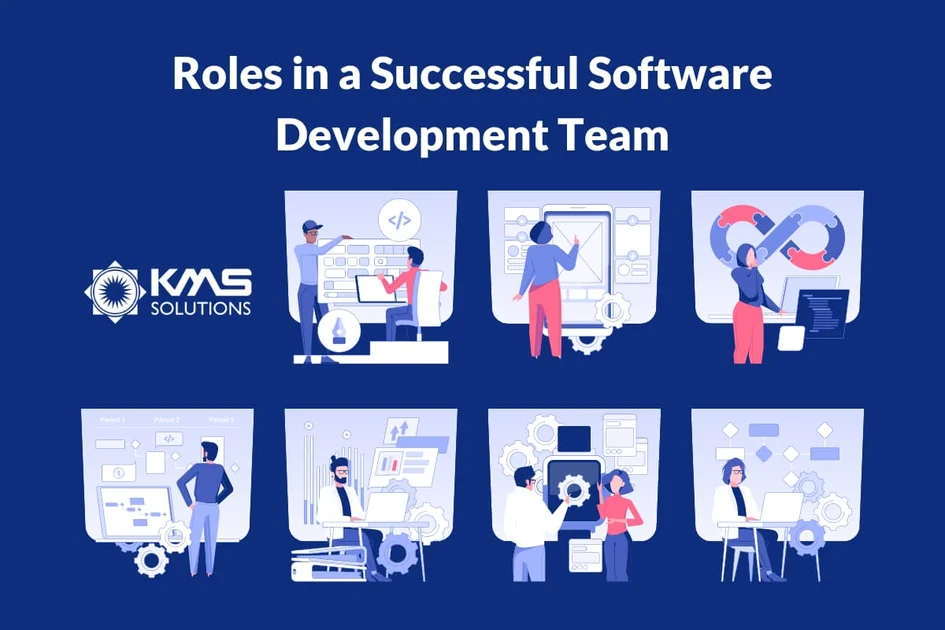Dedicated software development teams are more than simply developers and CTOs; they are a combination of various abilities required for different phases of a project, such as analysing, designing, developing, testing, etc. Having enough resources is a crucial factor for a banking project’s success. However, approximately 60% of IT projects fail owing to poor team organisation and/or a lack of recruiting.
Thus, top management should understand that a successful IT project in banking requires sufficient well-managed and trained team members in different roles. While hiring enough team members can take time and resources, banks and financial institutions now consider a dedicated development software team as an alternative. So, if you’re also looking to hire a remote IT team, here’s a list of must-have roles that you should consider.
1. Business Analyst – The Interpreter

Business Analysts (BA) are those who engage closely with stakeholders and dive deep into their requirements and processes to help them formulate business goals. As an “interpreter” of the team, BA helps translate the client’s vision into functional and technical languages that can be used by software developers to build the software.
BA plays an essential role at the beginning of digital banking projects with key responsibilities including:
- Requirements Gathering: Collaborate with stakeholders to gather and document business requirements.
- Data Analysis and Validation: Analyze the collected requirements, validating them through various models and ensuring they align with business goals.
- Process Mapping: Create detailed process maps and workflows to understand the current process and identify areas for improvement.
- Mockups Creation: Work with the design teams on the mockups of solutions that meet business needs and technical feasibility.
This role may involve the foundation stage, even before the software team is formed and continue to bridge the gap between the client and the team during later development phases.
Qualities that a good BA, especially in the banking project, should have include:
- A profound understanding of banking processes from various perspectives.
- A strongly developed imagination that can shape a software product to create maximum business value.
- A data-oriented mind to deal with numbers and data.
2. Product Owner – The Decision-maker
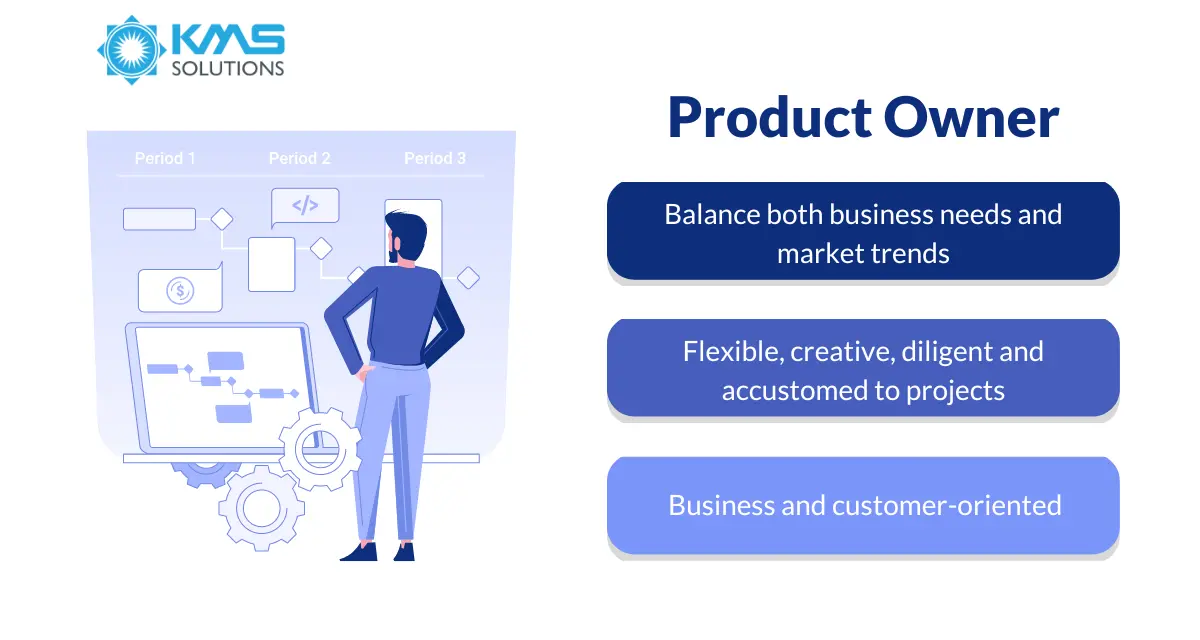 In a dedicated software development team, a Product Owner (PO) holds a heavier responsibility for a banking product’s success than other members. Balancing both business needs and market trends, they have the ability to define a business strategy, manage product backlog, and ensure the banking software satisfies client requirements.
In a dedicated software development team, a Product Owner (PO) holds a heavier responsibility for a banking product’s success than other members. Balancing both business needs and market trends, they have the ability to define a business strategy, manage product backlog, and ensure the banking software satisfies client requirements.
As a decision-maker and a captain of the dedicated software development team, the PO is responsible for:
- Project Planning: Develop detailed project plans, including roadmaps, milestones, and resource allocation.
- Team Coordination: Facilitate communication and collaboration among team members, ensuring everyone is aligned with the banking project goals.
- Risk Management: Identify potential risks and devise mitigation strategies to ensure project stability.
Associated mainly with flexible Agile environments, this role needs to be flexible, creative, diligent and accustomed to complicated banking projects, where requirements and workflows may change frequently. The reality is that an agile team will be challenged to bridge the business side of the project without a PO.
Possessing excellent knowledge of the project and user, the PO is more business and customer-oriented, while the BA is often more tactical and focused on the project.
3. Software Developer – The Keyman

No software development project is completed without the participation of coders. Since Software Developers are responsible for creating the final product by coding in a range of different programming languages, they’re essential to the success of a product’s delivery.
So, what traits of good developers are you looking for? Besides coherent coding skills, they need to be adaptable to technology trends, problem-solving and time-concerned to deliver a given task.
Depending on the complexity of the digital banking project, your dedicated software development team may have junior, mid and senior developers. However, in larger projects, you will often find different experience levels within the software development teams. Junior programmers can support the rest of the team by helping with simpler tasks, freeing up more senior developers to tackle complex coding. An experienced senior coder, on the other hand, will need to be sufficient in practices like agile development, know various task management software, understand regulatory compliance and is not afraid of working in various environments.
Developers are often categorised into:
- Software architectures: help design the overall system architecture, ensuring scalability, reliability, and performance. Determine the appropriate tech stacks and best practices.
- Front-end developers: create everything the end-user sees and interacts with. They focus on the usability and functionality of the software product to ensure a seamless user experience.
- Back-end developers: form the core of the application where all algorithms and business logic are implemented. In addition to writing code, experienced back-end developers are also responsible for devising an app architecture or implementing the necessary integrations.
- Full-stack developers: tackle projects that involve databases, and APIs, build user-facing websites, or even work with clients during the planning phase of projects.
4. Quality Assurance Engineer – The Nitpicker
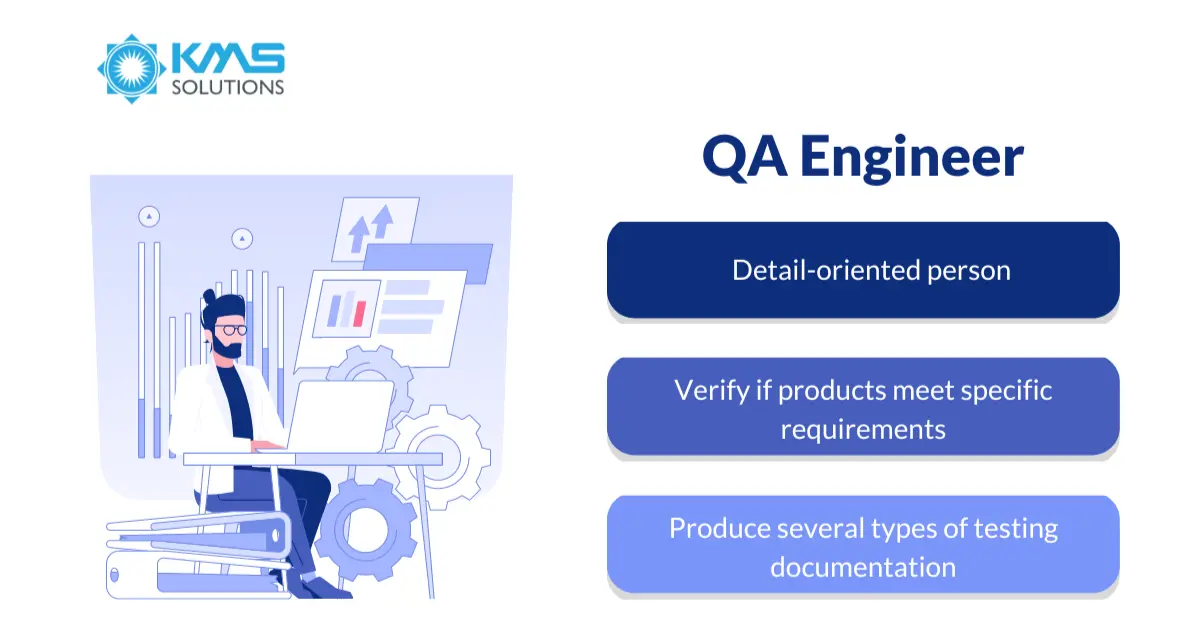
There will need to be a quality assurance (QA) specialist on a dedicated software development team to verify whether the banking software meets the requirements – both functional and non-functional ones.
QA engineers’ responsibilities include:
- Test Planning: Develop comprehensive test plans and test cases based on requirements.
- Test Execution: Verify an app from various angles, such as functionality, usability, security, or performance, requiring them to be proficient in many types of software testing.
- Testing Documentation: QAs produce test scenarios, test protocols, and test results reports to keep track of the checks and guarantee that all requirements are covered with tests.
In the dedicated software development team, a QA needs to be a detail-oriented person and has a strong concentration on delivering detailed test cases, running various checks, followed by analysing the test results and reporting on the banking app quality.
5. Automation Tester – The Accelerator

A test automation engineer is essential in the software development team as they can help enhance the speed and quality of the testing process. Since there are many repetitive tasks to ensure the quality of the banking app, this role is especially needed.
By creating test automation scripts, which are small programs that can provide reliable and constant feedback on software quality without the need for human involvement. Automation testers can help
- Handle regression tests or recurring tasks and increase the test coverage, while other QA engineers have time to check other test cases continuously.
- Advise clients on which components of an app are better suited for automation and which ones should only be tested manually.
- Establish an effortless test automation framework to maintain and upgrade.
- Ensure that your test automation strategy delivers the most outstanding possible value at a reasonable cost.
When hiring test automation specialists, you can check their knowledge of your currently-used automation testing tool and test management and bug-tracking solutions.
6. UX/UI Designer – The Mind-reader
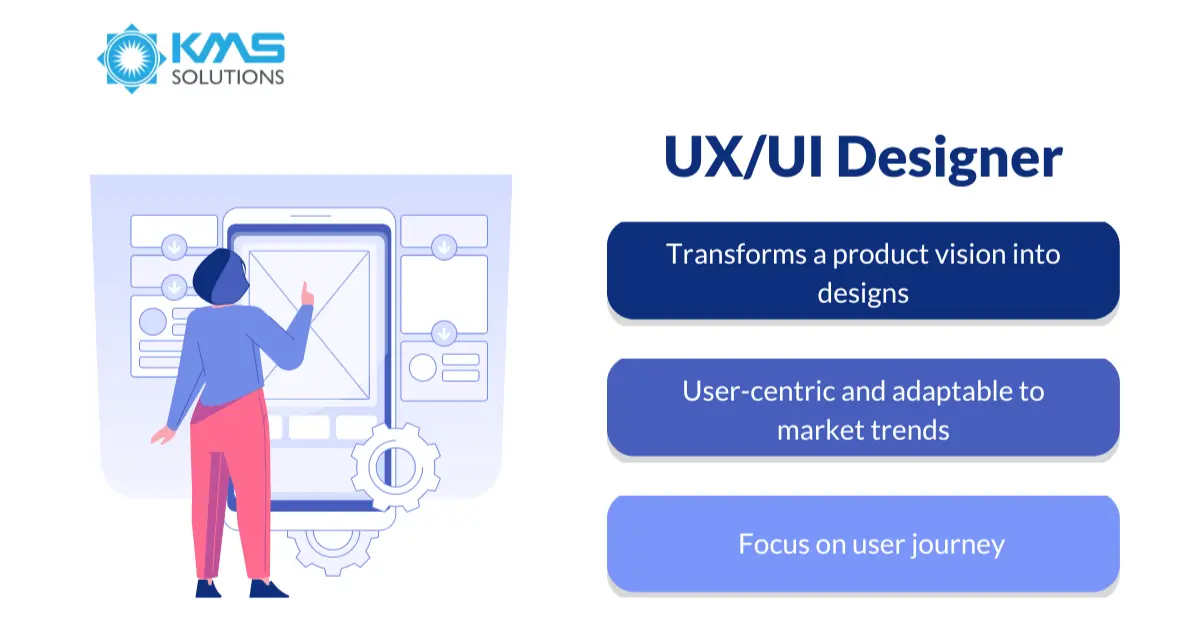
UI and UX designers, in collaboration with BA and engineers, often work closely together to turn clients’ ideas into intuitive products that match business requirements and satisfy users. While UX designer cares about identifying and solving user issues, UI designer is responsible for creating visualisable, aesthetically-pleasing, interactive interfaces. Generally, UX design comes first in the product development process, then followed by UI.
6.1 UX Designer
The primary responsibility of a UX designer is to be concerned with the user experiences when engaging with the final product. To ensure satisfaction, you should find a designer that is sympathetic, customer-centric, and knowledgeable about numerous approaches for determining whether their design works for the target consumers.
Such person-based work not only consists of analysing user behaviour. UX designers also need to take into consideration what the competition is doing, and continuously upgrade the design to win competitive advantages.
6.2 UI Designer
To get the product fully developed with the visual elements conform to the needs of users, a UI designer is needed. The primary responsibility of the UI designer is to prepare or design the user interface. This means transferring content, style, and graphics connected with a client or product to a system presentation layer.
Unless merged into one role on smaller projects, UX and UI designers primarily interact with each other. They also work closely with the programmers to make sure their designs can be brought to life through code.
Read more: Top 20 Best Practices for Mobile Banking App Designs In 2024
7. DevOps Engineer – The Balancer
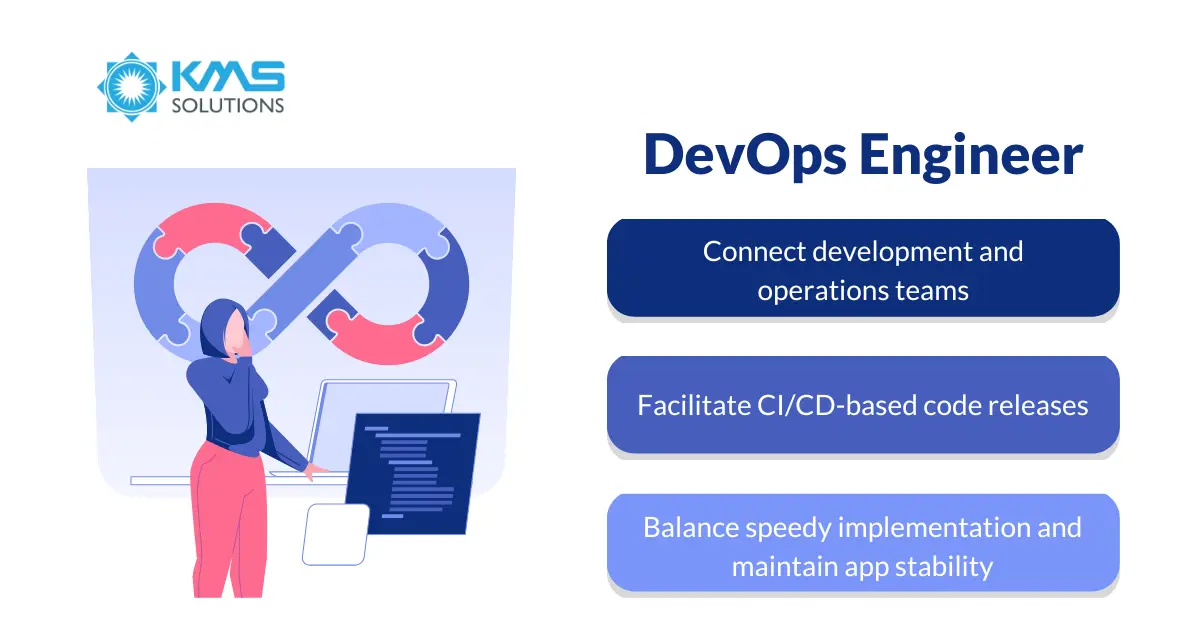
Even in Agile environments, development and operations teams can sometimes work in isolation from each other. To bridge this gap, DevOps engineers act as a liaison between the two teams, streamlining and automating the software delivery process. They aim to achieve a balance between the speedy implementation of changes and maintaining application stability.
Reponsibilities of the DevOps engineer in the digital banking project consist of:
- CI/CD Pipeline: Implement and manage continuous integration and continuous deployment (CI/CD) pipelines.
- Infrastructure Management: Manage cloud infrastructure and ensure its scalability, security, and reliability.
- Monitoring and Logging: Set up monitoring and logging systems to detect and resolve issues proactively.
A DevOps engineer should have wide-ranging knowledge of both development and operations, including coding, infrastructure management, system administration, and DevOps toolchains. In collaboration with software developers, system administrators, and operational personnel, DevOps engineers supervise and facilitate CI/CD-based code releases.
Find a Remote Dedicated Software Development Team You Can Trust
Now, as you know more about dedicated software development team roles and responsibilities, you can make more conscious decisions for your team structure.
Your software team members should be skilled, versatile and eager to cooperate, exchanging knowledge and visions. It’s also important to understand that the team size doesn’t matter, but the quality of the output does. So, here’re some key factors that you need to look for when engaging the new software team:
Identify Project Size & Budget
Your banking project size and budget will determine the structure and size of your software development team. For small budgets and scopes, consider a small generalist or hybrid team of freelance developers with diverse skills.
For larger budgets and projects, opt for a large generalist, specialist, or hybrid team of dedicated or in-house developers. Dedicated teams work full-time on a specific project and cost more than freelancers but less than in-house developers. Hire in-house developers only if you have a steady flow of projects to keep them consistently employed.
Seek Complementary Skills
Hiring team members with complementary skills enhances project effectiveness and efficiency. For instance, when developing a mobile app, consider:
- A Scrum Master to ensure adherence to Scrum principles
- A Java back-end developer for the banking app’s back-end
- A React front-end developer for the banking app’s front end
- A business intelligence analyst to extract valuable insights from data, which UI/UX designers and front-end developers can use to improve the app.
Engage with a Trusted Software Development Team that Has Banking Domain Knowledge
To ensure that the product’s outcome is well-aligned with the business goals, it’s essential to engage with a trusted digital team that possesses deep banking domain knowledge is crucial. Such a team understands the unique challenges and regulatory requirements of the financial industry, ensuring that the solutions they deliver are not only technologically robust but also compliant with industry standards.
Additionally, their familiarity with common pain points in the banking industry allows them to develop solutions that are both innovative and practical.
Consider KMS Solutions as Your Trusted Partner in Outsourcing a Software Development Team
Our team of experts possesses extensive knowledge and practical experience with various development frameworks to analyze your bank’s specific needs and offer customized recommendations. Additionally, we provide ongoing consultation and mobile banking app modernization services to help banks and financial institutions enhance customer experience and gain a competitive edge.
- KMS Solutions ensures regulatory compliance with standards like PCI DSS, ISOC 2, ISO 27001, and more, guaranteeing secure banking apps.
- Our experts hold certifications including, 12 AWS certifications, CBDP, PSM, PMP, and Scale Agile.
- We are proficient in over 50 technology stacks for digital banking, such as Python, Java, Kotlin, React Native, and Flutter.
- Having completed over 100 projects with an impressive 98% project satisfaction rate, we have collaborated with major players in the BFSI industry, including a Big Four Australian bank, ACB, HDBank, Discovermarket, Axi Trading, and many others.
Selecting the right APIs is critical. Start by identifying the specific functionalities you need, such as payment processing, customer verification, or data analytics. Once chosen, plan your architecture to ensure seamless integration. This includes deciding where the API will fit within your system, how data will flow, and ensuring there is minimal disruption to existing services.




